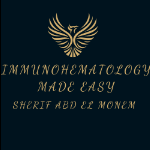Reputation Activity
-
 Neil Blumberg got a reaction from Judes in CPDA-1 Blood
Neil Blumberg got a reaction from Judes in CPDA-1 Blood
Our Red Cross just informed us that it will discontinue providing CPDA-1 rbc. We primarily used it to provide volume reduced red cells to pediatric patients under 3 years of age. We will volume reduce AS-1 or AS-3 by centrifugation or washing (Terumo 2991) instead. Probably unnecessary for most patients, but this is a long standing practice here, and it doesn't seem worthwhile trying to adjust pediatric practice in this regard. Most patients do not need the additional volume provided by the anticoagulant-preservative in AS-1, etc., and avoiding unnecessary volume is a reasonable goal in many patients.
There is no inherent virtue to CPDA-1 vs. AS-1 and similar solutions, and rbc preservation is slightly better in AS-1/AS-3 by in vitro metrics. There is absolutely no factual basis for using CPD-A1 in preference to AS-1, etc. in pediatrics. Purely expert opinion and probably unduly conservative.
I've attached a nice presentation by Dr. Saifee at the University of Washington, who createdAdditive solution AS-1 in Children Univ. Washington presentation Dec 2021.pptx it to educate her colleagues about using AS-1 instead of CPDA-1.
Additive solution AS-1 in Children Univ. Washington presentation Dec 2021.pptx
Pediatric RBC White Paper - November 2021.pdf
-
 Neil Blumberg got a reaction from TreeMoss in CPDA-1 Blood
Neil Blumberg got a reaction from TreeMoss in CPDA-1 Blood
Our Red Cross just informed us that it will discontinue providing CPDA-1 rbc. We primarily used it to provide volume reduced red cells to pediatric patients under 3 years of age. We will volume reduce AS-1 or AS-3 by centrifugation or washing (Terumo 2991) instead. Probably unnecessary for most patients, but this is a long standing practice here, and it doesn't seem worthwhile trying to adjust pediatric practice in this regard. Most patients do not need the additional volume provided by the anticoagulant-preservative in AS-1, etc., and avoiding unnecessary volume is a reasonable goal in many patients.
There is no inherent virtue to CPDA-1 vs. AS-1 and similar solutions, and rbc preservation is slightly better in AS-1/AS-3 by in vitro metrics. There is absolutely no factual basis for using CPD-A1 in preference to AS-1, etc. in pediatrics. Purely expert opinion and probably unduly conservative.
I've attached a nice presentation by Dr. Saifee at the University of Washington, who createdAdditive solution AS-1 in Children Univ. Washington presentation Dec 2021.pptx it to educate her colleagues about using AS-1 instead of CPDA-1.
Additive solution AS-1 in Children Univ. Washington presentation Dec 2021.pptx
Pediatric RBC White Paper - November 2021.pdf
-
 Neil Blumberg got a reaction from Mabel Adams in CPDA-1 Blood
Neil Blumberg got a reaction from Mabel Adams in CPDA-1 Blood
Our Red Cross just informed us that it will discontinue providing CPDA-1 rbc. We primarily used it to provide volume reduced red cells to pediatric patients under 3 years of age. We will volume reduce AS-1 or AS-3 by centrifugation or washing (Terumo 2991) instead. Probably unnecessary for most patients, but this is a long standing practice here, and it doesn't seem worthwhile trying to adjust pediatric practice in this regard. Most patients do not need the additional volume provided by the anticoagulant-preservative in AS-1, etc., and avoiding unnecessary volume is a reasonable goal in many patients.
There is no inherent virtue to CPDA-1 vs. AS-1 and similar solutions, and rbc preservation is slightly better in AS-1/AS-3 by in vitro metrics. There is absolutely no factual basis for using CPD-A1 in preference to AS-1, etc. in pediatrics. Purely expert opinion and probably unduly conservative.
I've attached a nice presentation by Dr. Saifee at the University of Washington, who createdAdditive solution AS-1 in Children Univ. Washington presentation Dec 2021.pptx it to educate her colleagues about using AS-1 instead of CPDA-1.
Additive solution AS-1 in Children Univ. Washington presentation Dec 2021.pptx
Pediatric RBC White Paper - November 2021.pdf
-
 Neil Blumberg got a reaction from jnadeau in CPDA-1 Blood
Neil Blumberg got a reaction from jnadeau in CPDA-1 Blood
Our Red Cross just informed us that it will discontinue providing CPDA-1 rbc. We primarily used it to provide volume reduced red cells to pediatric patients under 3 years of age. We will volume reduce AS-1 or AS-3 by centrifugation or washing (Terumo 2991) instead. Probably unnecessary for most patients, but this is a long standing practice here, and it doesn't seem worthwhile trying to adjust pediatric practice in this regard. Most patients do not need the additional volume provided by the anticoagulant-preservative in AS-1, etc., and avoiding unnecessary volume is a reasonable goal in many patients.
There is no inherent virtue to CPDA-1 vs. AS-1 and similar solutions, and rbc preservation is slightly better in AS-1/AS-3 by in vitro metrics. There is absolutely no factual basis for using CPD-A1 in preference to AS-1, etc. in pediatrics. Purely expert opinion and probably unduly conservative.
I've attached a nice presentation by Dr. Saifee at the University of Washington, who createdAdditive solution AS-1 in Children Univ. Washington presentation Dec 2021.pptx it to educate her colleagues about using AS-1 instead of CPDA-1.
Additive solution AS-1 in Children Univ. Washington presentation Dec 2021.pptx
Pediatric RBC White Paper - November 2021.pdf
-
 Neil Blumberg got a reaction from Malcolm Needs in Dr Peter D Issitt.
Neil Blumberg got a reaction from Malcolm Needs in Dr Peter D Issitt.
Peter was always helpful, gracious and supportive of everyone in the field. He made great contributions, not least of which was his definitive book Applied Blood Group Serology, which was recently reprinted. A fabulous reference for the ages. Doubt it will ever be replaced or exceeded. Hail and farewell.
-
 Neil Blumberg got a reaction from mpmiola in Adverse Transfusion Event Case Studies: Part 1, Pulmonary Transfusion Reactions.
Neil Blumberg got a reaction from mpmiola in Adverse Transfusion Event Case Studies: Part 1, Pulmonary Transfusion Reactions.
While it is infrequently referenced, universal leukoreduction is one strategy for minimizing pulmonary and cardiovascular adverse responses to transfusion (see attached). When we instituted it in 2000 our rate of TRALI decreased by 80+ % and TACO decreased by 50%. Probably mechanism is that white cells, DNA, histones and neutrophil extracellular traps (NETs) cause acute lung injury and inflammation when infused (good animal model data exist). Thus the failure to implement universal leukoreduction in the USA during the last 23-25 years was a terrible and tragic mistake, and this fatal error persists to this day.
ULR TRALI TACO PMC version.pdf
-
 Neil Blumberg got a reaction from Ensis01 in Adverse Transfusion Event Case Studies: Part 1, Pulmonary Transfusion Reactions.
Neil Blumberg got a reaction from Ensis01 in Adverse Transfusion Event Case Studies: Part 1, Pulmonary Transfusion Reactions.
While it is infrequently referenced, universal leukoreduction is one strategy for minimizing pulmonary and cardiovascular adverse responses to transfusion (see attached). When we instituted it in 2000 our rate of TRALI decreased by 80+ % and TACO decreased by 50%. Probably mechanism is that white cells, DNA, histones and neutrophil extracellular traps (NETs) cause acute lung injury and inflammation when infused (good animal model data exist). Thus the failure to implement universal leukoreduction in the USA during the last 23-25 years was a terrible and tragic mistake, and this fatal error persists to this day.
ULR TRALI TACO PMC version.pdf
-
 Neil Blumberg got a reaction from Sherif Abd El Monem in Adverse Transfusion Event Case Studies: Part 1, Pulmonary Transfusion Reactions.
Neil Blumberg got a reaction from Sherif Abd El Monem in Adverse Transfusion Event Case Studies: Part 1, Pulmonary Transfusion Reactions.
While it is infrequently referenced, universal leukoreduction is one strategy for minimizing pulmonary and cardiovascular adverse responses to transfusion (see attached). When we instituted it in 2000 our rate of TRALI decreased by 80+ % and TACO decreased by 50%. Probably mechanism is that white cells, DNA, histones and neutrophil extracellular traps (NETs) cause acute lung injury and inflammation when infused (good animal model data exist). Thus the failure to implement universal leukoreduction in the USA during the last 23-25 years was a terrible and tragic mistake, and this fatal error persists to this day.
ULR TRALI TACO PMC version.pdf
-
 Neil Blumberg got a reaction from John C. Staley in Adverse Transfusion Event Case Studies: Part 1, Pulmonary Transfusion Reactions.
Neil Blumberg got a reaction from John C. Staley in Adverse Transfusion Event Case Studies: Part 1, Pulmonary Transfusion Reactions.
While it is infrequently referenced, universal leukoreduction is one strategy for minimizing pulmonary and cardiovascular adverse responses to transfusion (see attached). When we instituted it in 2000 our rate of TRALI decreased by 80+ % and TACO decreased by 50%. Probably mechanism is that white cells, DNA, histones and neutrophil extracellular traps (NETs) cause acute lung injury and inflammation when infused (good animal model data exist). Thus the failure to implement universal leukoreduction in the USA during the last 23-25 years was a terrible and tragic mistake, and this fatal error persists to this day.
ULR TRALI TACO PMC version.pdf
-
 Neil Blumberg got a reaction from Sherif Abd El Monem in Immune Hemolytic Anemias- Petz and Garratty
Neil Blumberg got a reaction from Sherif Abd El Monem in Immune Hemolytic Anemias- Petz and Garratty
Larry Petz died about a year ago. He had completed a transition to working on cellular therapies in his later old age. Here's his obituary. He had a long and very productive life.
https://obituaries.neptunesociety.com/obituaries/sherman-oaks-ca/lawrence-petz-10780477
-
 Neil Blumberg reacted to Malcolm Needs in Patient hx
Neil Blumberg reacted to Malcolm Needs in Patient hx
My own experience with an antibody card that would have been useful, from 2007. Slides 5 and 25 are of particular interest from my own point of view! It should be noted that I no longer work for the NBS/NHSBT, and am no longer entitled to put CSci FIBMS after my name, although I am entitled to put FBBTS after it. Funny old world!
COADOA.ppt
-
 Neil Blumberg got a reaction from SbbPerson in Patient hx
Neil Blumberg got a reaction from SbbPerson in Patient hx
One additional approach would be to increase the sensitivity of the antibody screen by your preferred method (e.g., PEG, ± using enzyme treated red cells). Obviously increases the possibility of detecting pan-reactivity/false positive tests.
-
 Neil Blumberg got a reaction from Ensis01 in Patient hx
Neil Blumberg got a reaction from Ensis01 in Patient hx
We send cards to physicians (for their patients, if they like) because it is our responsibility to patients, not because it works well.
If anyone has better ideas, please share them. Obviously a national database would be best.
Doing absolutely nothing is not an option from our standpoint.
-
 Neil Blumberg got a reaction from Malcolm Needs in Patient hx
Neil Blumberg got a reaction from Malcolm Needs in Patient hx
We send cards to physicians (for their patients, if they like) because it is our responsibility to patients, not because it works well.
If anyone has better ideas, please share them. Obviously a national database would be best.
Doing absolutely nothing is not an option from our standpoint.
-
 Neil Blumberg got a reaction from AMcCord in Patient hx
Neil Blumberg got a reaction from AMcCord in Patient hx
Another thing to try to increase sensitivity (other than PEG or other enhancement) is to increase the serum/cell ratio in the screen/indirect antiglobulin test. If there is no reactivity with enhancement, enzyme treated rbc (agree with Malcolm's caveat that some antigens will be destroyed) and increased serum/cell, one can be more confident there is nothing detectable pre-transfusion. Some consolation at least ...
-
 Neil Blumberg got a reaction from John C. Staley in Patient hx
Neil Blumberg got a reaction from John C. Staley in Patient hx
Another thing to try to increase sensitivity (other than PEG or other enhancement) is to increase the serum/cell ratio in the screen/indirect antiglobulin test. If there is no reactivity with enhancement, enzyme treated rbc (agree with Malcolm's caveat that some antigens will be destroyed) and increased serum/cell, one can be more confident there is nothing detectable pre-transfusion. Some consolation at least ...
-
 Neil Blumberg got a reaction from Malcolm Needs in Patient hx
Neil Blumberg got a reaction from Malcolm Needs in Patient hx
Another thing to try to increase sensitivity (other than PEG or other enhancement) is to increase the serum/cell ratio in the screen/indirect antiglobulin test. If there is no reactivity with enhancement, enzyme treated rbc (agree with Malcolm's caveat that some antigens will be destroyed) and increased serum/cell, one can be more confident there is nothing detectable pre-transfusion. Some consolation at least ...
-
 Neil Blumberg got a reaction from John C. Staley in Patient hx
Neil Blumberg got a reaction from John C. Staley in Patient hx
One additional approach would be to increase the sensitivity of the antibody screen by your preferred method (e.g., PEG, ± using enzyme treated red cells). Obviously increases the possibility of detecting pan-reactivity/false positive tests.
-
 Neil Blumberg got a reaction from Kelly Guenthner in Antigen typing during pregnancy
Neil Blumberg got a reaction from Kelly Guenthner in Antigen typing during pregnancy
Not a sensible approach in my opinion. No real chance of mistyping due to fetal bleed. At very least, you'd see a mixed field if there were a fetal bleed with a different type. So get rid of this requirement in my view.
-
 Neil Blumberg got a reaction from AuntiS in Antigen typing during pregnancy
Neil Blumberg got a reaction from AuntiS in Antigen typing during pregnancy
Not a sensible approach in my opinion. No real chance of mistyping due to fetal bleed. At very least, you'd see a mixed field if there were a fetal bleed with a different type. So get rid of this requirement in my view.
-
 Neil Blumberg got a reaction from John C. Staley in Antigen typing during pregnancy
Neil Blumberg got a reaction from John C. Staley in Antigen typing during pregnancy
Not a sensible approach in my opinion. No real chance of mistyping due to fetal bleed. At very least, you'd see a mixed field if there were a fetal bleed with a different type. So get rid of this requirement in my view.
-
 Neil Blumberg got a reaction from Yanxia in Antigen typing during pregnancy
Neil Blumberg got a reaction from Yanxia in Antigen typing during pregnancy
Not a sensible approach in my opinion. No real chance of mistyping due to fetal bleed. At very least, you'd see a mixed field if there were a fetal bleed with a different type. So get rid of this requirement in my view.
-
 Neil Blumberg got a reaction from Jsbneg in Antigen typing during pregnancy
Neil Blumberg got a reaction from Jsbneg in Antigen typing during pregnancy
Not a sensible approach in my opinion. No real chance of mistyping due to fetal bleed. At very least, you'd see a mixed field if there were a fetal bleed with a different type. So get rid of this requirement in my view.
-
 Neil Blumberg got a reaction from exlimey in Antigen typing during pregnancy
Neil Blumberg got a reaction from exlimey in Antigen typing during pregnancy
Not a sensible approach in my opinion. No real chance of mistyping due to fetal bleed. At very least, you'd see a mixed field if there were a fetal bleed with a different type. So get rid of this requirement in my view.
-
 Neil Blumberg got a reaction from Malcolm Needs in Antigen typing during pregnancy
Neil Blumberg got a reaction from Malcolm Needs in Antigen typing during pregnancy
Not a sensible approach in my opinion. No real chance of mistyping due to fetal bleed. At very least, you'd see a mixed field if there were a fetal bleed with a different type. So get rid of this requirement in my view.









